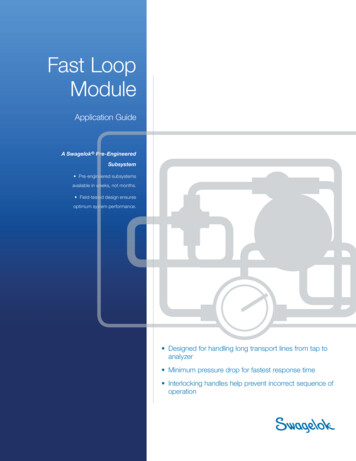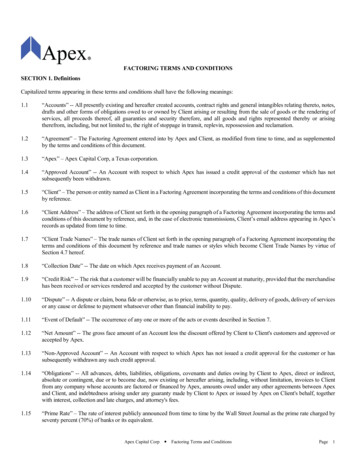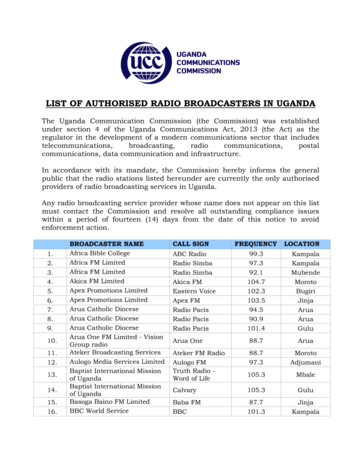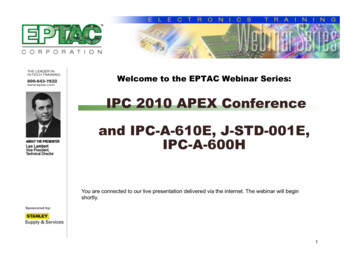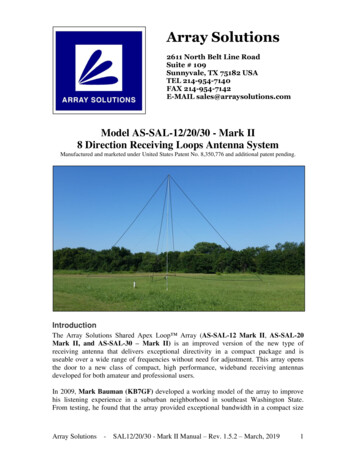
Transcription
Array Solutions2611 North Belt Line RoadSuite # 109Sunnyvale, TX 75182 USATEL 214-954-7140FAX 214-954-7142E-MAIL sales@arraysolutions.comModel AS-SAL-12/20/30 - Mark II8 Direction Receiving Loops Antenna SystemManufactured and marketed under United States Patent No. 8,350,776 and additional patent pending.IntroductionThe Array Solutions Shared Apex Loop Array (AS-SAL-12 Mark II, AS-SAL-20Mark II, and AS-SAL-30 – Mark II) is an improved version of the new type ofreceiving antenna that delivers exceptional directivity in a compact package and isuseable over a wide range of frequencies without need for adjustment. This array opensthe door to a new class of compact, high performance, wideband receiving antennasdeveloped for both amateur and professional users.In 2009, Mark Bauman (KB7GF) developed a working model of the array to improvehis listening experience in a suburban neighborhood in southeast Washington State.From testing, he found that the array provided exceptional bandwidth in a compact sizeArray Solutions- SAL12/20/30 - Mark II Manual – Rev. 1.5.2 – March, 20191
and provided good front-to-back and front-to-side ratio especially for local interferingsignals.The design of the array countered conventional wisdom by spacing a pair of loops onlyinches apart when state-of-the-art designs called for spacing on the order of around ¼wave length (over 100 feet on 160 meters). Numeric modeling of the array showed that,for closely spaced loops, the spacing between the loops was much less important than thelocation of the feed point along the base of each loop. This provided the opportunity tosimplify the installation because all of the loops could be held in place by a single nonconductive mast that acted as both a spacer and support.In addition, inserting ferrite beads along the base of the loop to form transformersprovided a convenient method of signal coupling as well as a great way to test variouscoupler locations. Modeling also showed a correlation between the coupler location andthe response pattern and backward elevation null angle which was also verified duringtesting.Utilizing the inherent front-to-side rejection of small loops made it possible to achieveboth front-to-back and front-to-side rejection using signals from only two loops and asingle delay line. This simplified the signal combining task, and made it possible tolocate all the signal processing electronics at a single position at the base of the array.Next, testing commenced on two orthogonal pairs of loops and switching circuits weredeveloped to provide electronic rotation of the pattern. This testing showed that eightindividual directions could be obtained using the four loops. These switching circuitsincluded a multiplexing scheme where the switching commands and power were sent onthe same feed line that returns the signals from the array. This technique greatlysimplifies the installation.Challenges remained, however before a commercial array could be made available.Designing the amplifier chain was especially difficult because of competing constraints.These included the need for closely matched input impedance over a wide frequencyrange (to ensure accurate timing), very low noise (because of negative forward gain),good gain (to overcome signal cancelation), and acceptable linearity. Finally, on 2013,though, after a period of extensive testing and improvement, the Shared Apex Loop array was ready for production.Mark’s constant experimentation has kept the SAL antenna evolving and this new versionthat replaces the four vertical wires of the loop running along the non-conductive mast forone common vertical conductor. This allows the use of aluminum tubing in place of thefour wires with an aluminum base section insulated from the common conductor. Thisopens the possibility of building experimental SAL antennas with bigger loops that wouldfavor very low frequencies (VLF) and the benefit of the structural improvement thatmakes the antenna easy to install even by of one person.Array Solutions- SAL12/20/30 - Mark II Manual – Rev. 1.5.2 – March, 20192
DescriptionIn principle, the array provides directivity by summing signals from one loop withdelayed signals from an oppositely phased and positioned loop. Both the delay and loopphasing are largely frequency independent providing a directive pattern over a widefrequency range.The array consists of four identical right triangle shaped wire loops that its vertical side iscommon to the four loops in the form of an aluminum mast insulated from the basesection. The loops are arranged around the mast so that one loop points towards thenortheast, another to the southeast, another to southwest, and another to the northwest.The direction and directional mode of the array is commanded by a controller thatconnects directly to your receiver. The controller has buttons for changing the direction,flipping to the opposite direction, and selecting the directional mode. The directionalmodes include a Single or UNI-directional mode as well as a dual or BI-directional mode.Visual indicators show the currently selected direction and directional mode. A remoteinterface is included that enables the controller to be commanded by a computer.A single RG-6 coaxial feed line connects the controller to the array to power andcommand the array as well as transport the received signals from the array to thecontroller.Ferrite couplers are located along the base of each loop at a specific distance from themast and connected to balanced feed lines that bring the signals to a switching unitArray Solutions- SAL12/20/30 - Mark II Manual – Rev. 1.5.2 – March, 20193
mounted on the mast. Relays in the switching unit route signals from the appropriatecombination of loops in response to commands received from the controller. A singledelay line also connects to the switching unit to provide the necessary true-time-delay sothat signals can be properly combined to achieve the desired directive pattern. Theswitching unit has a socketed dual stage preamplifier that provides a buffered andmatched load for the combiner and boosts the summed signals before they are sent to thecontroller.The AS-SAL-12 Mark II should provide a directional pattern up to 28 MHz. The ASSAL-20 Mark II should provide a directional pattern up to 14 MHz, and the AS-SAL-30Mark II up to 7 MHz.The Shared Apex Loop design provides the following benefits: Competitive Front to Back/Side rejection in eight directions especially on lowangle vertically polarized signals and local interference Compact footprint that is ideal for small yards Easy setup for tactical applications Wideband operation without need for adjustment that is great for SDR, Skimmersand military Ease of Construction, and quick deployment, DX-peditions, military, seasonaltake down is easy No RF ground at the antenna required Modular design – easy to replace parts Field upgradeable - amplifier stage is socketed No control cables; control and powered over the RG-6 coax feed line from thecontroller, very smart and cost effective design. The SAL Controller can be interfaced to a PC for remote operation.Array Solutions- SAL12/20/30 - Mark II Manual – Rev. 1.5.2 – March, 20194
SAL-12 Mark II Package ContentsSAL-12 Mark II Antenna Material ListQTYITEM1Aluminum 16 ft mast kit with hardware:102" x 1/4"-20 bolts with safety hex nuts26 ft (1.83 m) 1-1/2" (38.1 mm) OD aluminum tubing14 ft (1.83 m) 1-1/2" (38.1 mm) OD aluminum tubing (double wall)1Insert couplings 1-3/8" x 7" (34.9 mm x 182 mm) aluminum tubing1Insert coupling 1-3/8" x 3-1/2" (34.9 mm x 88.9mm) aluminum tubingFiberglass Insert coupling 1-1/4" x 7" (31.75 mm x 182 mm)1 (fiberglass insulator)8Solder eye lugs for 1/4" bolts (attached to the loops)LOOPS: 29' (10.36 m) cables for loops (with TX line, coupler, solder lugs4attached)4Anchoring Stakes402ft of rope to cut as follows*: 4 x 10 ft (3.05 m) guying ropesHose clamps 2"1441PVC Mast base with 4” pipe insertedTX LINES: 7 ft (2.13 m) 120 ohm WITH COUPLERS (attached to the loops)Guy rope tensionersDELAY LINE: 8’ -7 & 5/8” (2.63 m) RG-6 coaxial cable delay line (with Fconnectors attached)111Control SwitchCombiner/Pre-amp15v Power supply*Suggested cutting lengths may vary depending on site's topography.Array Solutions- SAL12/20/30 - Mark II Manual – Rev. 1.5.2 – March, 20195
SAL-20 Mark II Package ContentsSAL-20 Mark II Antenna Material ListQTYITEM1Aluminum 22 ft mast kit with hardware:142" x 1/4"-20 bolts with safety hex nuts36 ft (1.83 m) 1-1/2" (38.1 mm) OD aluminum tubing14 ft (1.83 m) 1-1/2" (38.1 mm) OD aluminum tubing (double wall)2Insert coupling 1-3/8" x 7" (31.75 mm x 182 mm) aluminum tubing1Insert coupling 1-3/8" x 3-1/2" (34.9 mm x 88.9 mm) aluminum tubingFiberglass Insert coupling 1-1/4" x 7" (31.75 mm x 182 mm) (fiberglass1 insulator)844402144Solder eye lugs for 1/4" bolts (attached to cable loops)LOOPS: 44' (10.36 m) CABLES FOR LOOPS (with TX line, coupler, andsolder lug)1Anchoring Stakesft of rope to cut as follows*: 4 x 10 ft (3.05 m) guying ropes.Hose clamps 2"PVC Mast base with 4” pipe insertedTX LINE: 10 ft (3.05 m) 120 ohm with COUPLERS (attached to the loops)Guy rope tensionersDELAY LINE: 14’ – 5 & 3/8” (4.403 m) RG-6 coaxial cable delay line with Fconnectors attached111Control SwitchCombiner/Pre-amp15v Power supply*Suggested cutting lengths may vary depending on site's topography.Array Solutions- SAL12/20/30 - Mark II Manual – Rev. 1.5.2 – March, 20196
SAL-30 Mark II Package ContentsSAL-30 Mark II Antenna Material ListQTYITEM1Aluminum 30 ft mast kit with hardware222" x 1/4"-20 bolts with safety hex nuts56 ft (1.83 m) 1-1/2" (38.1 mm) OD aluminum tubing14 ft (1.83 m) 1-1/2" (38.1 mm) OD aluminum tubing (double wall)2Tie-down "D" rings with plates for 1/4" bolts4Insert couplings 1-3/8" x 7" (34.9 mm x 182 mm) aluminum tubing1Insert coupling 1-3/8" x 3-1/2" (34.9 mm x 88.9mm) aluminum tubingFiberglass Insert coupling 1-1/4" x 7" (31.75 mm x 182 mm)1 (fiberglass insulator)8Solder eye lugs for 1/4" bolts (already attached to the loops)LOOPS: 65' (19.81 m) cables for loops (with TX line, coupler, solder lugs4attached)81804421481111Anchoring Stakesft of rope to cut as follows: *10 ft (3.05 m) guying ropes for outer stakes35 ft (10.67 m) guying ropes for inner stakesHose clamps 2"PVC Mast base (with 4” pipe inserted)TX LINE: 17 ft (5.18 m) 120 ohm with COUPLERS (attached to the loops)Guy rope tensionersDELAY LINE: 21’ – 3” (6m) RG-6 coaxial (with F connectors attached)Control SwitchCombiner/Pre-amp15v Power supply*Suggested cutting lengths may vary depending on site's topography.Array Solutions- SAL12/20/30 - Mark II Manual – Rev. 1.5.2 – March, 20197
The three models of the AS-SAL-XX Mark II Antenna contain the following parts:SAL-30 Mark II parts. Quantities for the three models specified on the texts.INSTALLATION** WARNING! INSTALLATION OF ANY ANTENNA NEAR POWER LINES ISDANGEROUS: Do not locate the antenna near overhead power lines or otherelectrical circuits where the antenna could come in contact with these circuits.When installing the antenna, take extreme care not to contact electrical power linesor circuits, because they may cause serious injury or death!Site SelectionThe Shared Apex Loop array works by summing signals from oppositely positionedand phased loops. For proper operation, it is essential that each loop in each loop pairhave identical signal response. Factors that can impact the signal response include: Size of the Loop Shape of the Loop Orientation of the Loop Distance of the Loop to the GroundArray Solutions- SAL12/20/30 - Mark II Manual – Rev. 1.5.2 – March, 20198
Distance from the Loop to other metal objectsThe ideal location for the array is on flat ground, away from any other objects. From ourtesting so far, we are finding that the Shared Apex Loop array is somewhat tolerant tothe presence of both metal and non-metal objects positioned near the loops. However,numeric modeling shows that there are limits to this tolerance.Based on this, here are some things to keep in mind: If the ground is uneven, try to mount the base of the loop at least 5 feet above theground. You will need additional mast pipe to accomplish this. Keep antenna away from large metallic structures like towers, and your transmitantennas. We recommend at least 1/4 Wavelength distance at the lowestfrequency of use. If needed, to avoid damage by people, animals or vehicles you can elevate yourinstallation. Simulations show that optimal height is ¼ W.L. at a given frequency.As an example of an AS-SAL-12 Mark II that has good directivity from 300 kHz to 28MHz, it is located with the edge of the array located 50 feet (15.24 m) from a house, 90feet (27.43 m) from overhead power lines, 30 feet (9.14 m) from ground mounted 36 foot(10.97 m) vertical with ground radials close to the edge of the array, 10 feet (3.05 m)from metal clothesline, and has an 8 foot (2.43 m) tall bush growing near the center.Required AreaSAL-30 Mark II approximately a clear flat 50 feet (15.24 m) square.SAL-20 Mark II approximately a clear flat 36 feet (10.97 m) square.SAL-12 Mark II approximately a clear flat 26 feet (7.92 m) square.NOTE: If insulated posts are used to anchor the outer corners of the loop, the footprintcan be reduced notoriously. See table and drawing below for comparison.Array Solutions- SAL12/20/30 - Mark II Manual – Rev. 1.5.2 – March, 20199
Installing the solder lugs and couplers on the wire sections of the loops*.*Array Solutions has pre-installed the couplers and ring terminals forthe user, but in case you need to make your own wire assemblies here ishow to do it. Pay attention to the coupler polarity.The solder lugs come attached to the loop cables. If they are not: Two are needed perloop, one at both ends of the wire section of the loops.First install and solder the lug at the end that is going to be attached at the apex (top) ofthe antenna. Use rubber tape or other material like shrink tubing to protect the connectionof the stainless steel lug with the copper of the #14 wire and the solder applied to it.Solder lug and wire connectionprotected with shrink tubing. Rubbertape can be used as well.Crimped and soldered lug.Before proceeding to install the solder lugs at the bottom ends of the wire section is important topass the wire through the couplers, to install the couplers in the right way is IMPORTANT TOINTRODUCE THE WIRE BY THE END OF THE FERRITES TUBE THAT HAS THE REDWIRE coming out of it. This way, the couplers will be oriented with the red wire towards theouter corner of the loops. Refer to the drawing and the following picture below:Array Solutions- SAL12/20/30 - Mark II Manual – Rev. 1.5.2 – March, 201910
The wires used may be different colors just make the orientation of each set of balancedtransmission lines to be the same for each of the 4 loops. The polarity of the loop couplersshould be symmetrically oriented on all 4 loops.NOTE: If this is the black and white printout of the manual sent along with the antenna,please refer to the manual with color pictures and drawings available on our webpage forclarity.Detail of couplers connections and orientation. For B&W printouts, note the wires marked “red”.The other wires are black. Positive sign, “ ” is red.Array Solutions- SAL12/20/30 - Mark II Manual – Rev. 1.5.2 – March, 201911
The end shown is the bottom end of the wire, note the black wire of the coupler coming out ofthe end of the coupler.Tips to thread the wire through the couplers:-Do not attempt to pass the #14 wire through the coupler’s ferrites tube after removing the plasticinsulation from the wire. The wire is made of seven strands semi-rigid solid coper wire and thestrands could peel off the insulation of the #22 wires installed in the coupler, this will cause ashort and the coupler won’t work as intended.-Best option is to remove about 1/2 inch (12.7 mm) of insulation and, keeping the strandstogether, apply solder to it, this will make passing the wire easier than doing it with theinsulation covering the copper to the end of the wire.-Be careful in order to avoid any damage to the inner red and black #22 insulated wires.-After passing the wire through the coupler the second solder lug can be installed.Connecting the wire sections to the top of the mast.Align the holes of the short insert of aluminum tubing that goes at the top of the top section ofmast. Insert one 3/16” bolt through the top end lug of one of the wires orienting the lug in a waythat its flat side will be against the aluminum tubing.Pass the bolt through the holes of the tubing and attach the opposite loop wire lug keeping its flatface towards the aluminum. Use one of the hexagonal nuts to secure the connections and keepthe wires oriented towards the bottom of the tubing while tightening the nut.Do the same with the second pair of wire sections, when the four wires are attached to the topsection, use one of the two hose clamps provided and install it in such a way that it removes thestress from the solder lugs. The clamp should be over the wires and not on any part of the solderArray Solutions- SAL12/20/30 - Mark II Manual – Rev. 1.5.2 – March, 201912
lug. When finished, it should look like in the picture below:The four top ends of the wires connected to the apex of the antenna, and the hose clampused to relieve the tension from the connection lugs.It is recommended that the connections here are protected. It is highly suggested that Noalox ora similar product should be applied between the lug and the aluminum tubing to protect theconnection from galvanic corrosion between the stainless steel and the aluminum. Also cover theconnections with rubber tape or any other material to protect them from the weather.Connections at the bottomDepending on the antenna model and the number of persons involved on the installation, youmay decide to connect the bottom ends of the wire sections before or after assembling anderecting the mast. Proceeding like with the antenna top connections, do the same at the bottom,just above the insulated coupling on top of the 4 feet base mast section. Wires should be, again,oriented downwards while tightening the hex nuts. Refer to the picture to see how it should lookwhen finished. It is highly recommended to protect these connections from the weather elements.Array Solutions- SAL12/20/30 - Mark II Manual – Rev. 1.5.2 – March, 201913
Detail of bottom connections.Assembling the MastIt is time to assembly the mast with the corresponding number of aluminum sections dependingon your model. Please refer to the drawing below:Mast layoutsArray Solutions- SAL12/20/30 - Mark II Manual – Rev. 1.5.2 – March, 201914
First, install the corresponding inserts on top of each mast section following the pictures below.There is a base section 4 ft (1.22 m) long, install the fiberglass insert on top of it and use two ofthe 3/16” x 2” bolts and corresponding hexagonal safety nuts to secure it.The first section above the base is 6 ft (1.83 m) long and has a riveted insert at the bottom tomatch the wall thickness of the base section in order to accommodate the fiberglass insert thatconnects them.The rest of sections use the 6” aluminum inserts except for the top section which uses the shorteraluminum insert and most be installed flush with the end of the top section.After the first section above the base mast section the different models have the followingnumber of 6 ft (1.83 m) sections:SAL-12 Mark II: One section (the top one with the shorter insert)SAL-20 Mark II: Two sections (Including the top section with the shorter insert).SAL-30 Mark II: Four sections (Including the top section with the shorter insert).For a graphic reference, please see the different “Mast Layouts” above.Array Solutions- SAL12/20/30 - Mark II Manual – Rev. 1.5.2 – March, 201915
Coupling inserts. Leftmost is the fiberglass insulator for the top of the base mast section.Short one is 4-3/4” (120 mm) for the top section. The rest are 7-1/8” (182 mm) long.NOTE: SHORT COUPLER MAY BE PREINSTALLED IN TOP SECTION.Mast sections with its coupling inserts attached at their tops. Note the two tie down “D”rings for guy ropes at the top of the fourth section (SAL-30 Mark II only) and the shortestArray Solutions- SAL12/20/30 - Mark II Manual – Rev. 1.5.2 – March, 201916
insert to reinforce the tubing at the connection point at the antenna apex, it is flush with thetop section’s end.SAL-30 Mark II wire loop section and guy ropes layout. Wires are in red.Array Solutions- SAL12/20/30 - Mark II Manual – Rev. 1.5.2 – March, 201917
SAL-20 Mark II wire loop section layout.SAL-12 Mark II wire loop section layout.View of the SAL-30 Mark-II antenna. The loops’ wires have been edited thicker for clarity.The thin lines are the guying ropes.Array Solutions- SAL12/20/30 - Mark II Manual – Rev. 1.5.2 – March, 201918
** WARNING! INSTALLATION OF ANY ANTENNA NEAR POWER LINES ISDANGEROUS! **Installation Instructions-Site Preparationo Prepare the location that the mast will mount. This may include installing a sleeve in theground to receive the mast, preparing a hole, or pouring a concrete, etc. Do not yet raisethe mast as you will need access to the top of the mast.o Select the location for the mast. Then, measure (33 feet for the SAL-30, 25.5 feet for theSAL-20 and 18.5 feet for the SAL-12) in a northeast direction and drive a loop stakesinto the ground. Repeat this for the southeast, southwest, and northwest directions,stakes. Verify that each stake is in line with the center and its opposite stake. Please seeAppendixes 2a and 2b, suggestions on how to establish perpendicular lines on the fieldNote: These measurements are for ground mounted installations. For raised installations,the stake distance will need to be adjusted to properly tension the loops.-Loop installationo The loops should have a right angle triangle shape to it when finished. The lowerhorizontal will have to have the loop couplers slid onto it. The polarity should be thesame on all the couplers. All must be oriented so that the red wire or “ ”, orpositive, that enters into the ferrites tube by one of its ends faces away from themast on all of the couplers. This red wire should be connected to the corresponding“ ” terminal in the combiner box. The black wire is the “-“ or negative, is the oneentering by the end of the ferrite tube that should be closest to the mast andconnected to the corresponding “-“ terminal. (Please refer to either the drawing or thepicture on page 10). Make sure that the loop is not tangled with any of the other loopwires. Next, repeat these steps for the remaining three loops.o Next, prepare the four tether ropes, each being about 10 feet long. Form a loose fittingknot around each of the four loops near the outer corner of each loop. A bowline knotworks well. Also string on a rope tension device on each rope as shown in the picture.Array Solutions- SAL12/20/30 - Mark II Manual – Rev. 1.5.2 – March, 201919
The tensioner pictures below show how the triangular tensioners work by rotating it enough to make thelong branch of the rope straight (in this picture it would be counter clock wise) and then moving thetensioner up or down the rope if more tension or less tension is needed correspondingly.Outer corner of loop, once you have thehorizontal dimension set, put tape tightly or usetie-wraps to avoid the rope from slipping andchanging the dimension of the horizontal side ofeach loop.Triangle Tensioner: The one shown in thepicture, when rotated counter clock wise willstraighten the long branch of rope allowing theadjusting of the guy rope tension.Array Solutions- SAL12/20/30 - Mark II Manual – Rev. 1.5.2 – March, 201920
Mast installationo Next, raise the mast with the attached wires sections of the loops, gatheringappropriate help if needed to hold the mast in place while the loops are beinganchored to the stakes which you drive into the ground with a hammer (In thecase of the SAL-30 Mark II secure first the guy ropes and the inner set ofstakes, the four ropes are tied to the two tie-down D rings at the top of the 4thsection). Loop the tensioner bail over the stake and adjust tension on the tetherrope. Tie off any excess rope around stake so the tensioner will not accidentallyslip off in high winds.o Then, adjust the mast and the tethers so that the mast is vertical and that the loopshave the same size and shape.o The Horizontal part of each loop must be leveled and not sloping away ortowards the flat ground.oMeasure and adjust the distance from the mast to the tether point so that thisdistance is the same for all of the loops. Also, adjust the tension on the tethers oneach loop to minimize sag.o Verify again that the mast is vertical. Repeat previous step until all loops are thesame size and shape, and horizontal sections of loops are horizontal.o If the ground where the antenna is not flat and even, and there is the need toelevate the outer corners, make the slope and length of the lower wire equal for allfour loops. The couplers may need to be positioned closer to the mast, thereforestart at the recommended distance for the horizontal case and try to optimize theF/B of the antenna moving the couplers towards the mast.o The horizontal length, mostly on the largest model, the SAL-30, is about 25 ft(7.62 m), not an exact dimension that depends on the wire sag and tensionapplied to it. Just pull the wire and adjust the length while keeping itArray Solutions- SAL12/20/30 - Mark II Manual – Rev. 1.5.2 – March, 201921
horizontal until a reasonable tension is applied to the diagonal wire going tothe top of the mast. This applies to the smaller models as well.o-Failure to make the loops closely the same size and shape will result in less thanoptimal results, especially below 4 MHz!Switching unit (combiner) installationo Remove the cover of the switching unit so that the loop terminals are exposed.See picture on next page.o Route the northeast loop balanced line through one of the holes in the bottom ofthe switching unit. Connect the red ( ) wire to the NE terminal and the black (-)wire to the NE- terminal.o Route the southwest loop balanced line through one of the holes in the bottom ofthe switching unit. Connect the red ( ) wire to the SW terminal and the black (-)wire to the SW- terminal.o Route the southeast loop balanced line through one of the holes in the bottom ofthe switching unit. Connect the red ( ) wire to the SE terminal and the black (-)wire to the SE- terminal.o Route the northwest loop balanced line through the remaining hole in the bottomof the switching unit. Connect the red ( ) wire to the NW terminal and the black(-) wire to the NW- terminal.o Verify that the balanced lines are connected to the appropriate terminals. Youshould see a repeating pattern of wire colors (i.e. red-black - red-black - red-black- red-black).o Note: The array will NOT be directive if the balanced lines are not connected inthe proper order!o Reinstall the cover onto the switching unit.o Mount the switching unit to the mast with a couple of tie wraps, the bottom guybracket makes a nice place for the top tie-wrap. See picture.o Connect the ends of the RG-6 delay line to the two side by side at the same levelF- female connectors on the front of the switching unit (see picture below).o Connect the RG-6 feed line to the controller to the F-female top connector on thefront of the switching unit. It is the connector on upper part of the box.o Is recommended the use of coax tape on the RG-6 connectors to protect themfrom the weather.WARNING!Do not insert any device in the RG-6 or the transmission line betweenthe Combiner and the Controller of the SAL antenna. Most devices area short circuit for DC and the command pulses and 15 V DC are sent tothe combiner using the transmission. This can damage the device, theCombiner and Controller of the SAL antenna.Array Solutions- SAL12/20/30 - Mark II Manual – Rev. 1.5.2 – March, 201922
Close up views of combiner and connections. The PVC four way 1-1/4” coupling(not supplied) is a suggestion of what could be used to keep the couplerstransmission lines away from themselves, the RG-6 cables and from the metallicmast. You can use wooden stakes or PVC pipes driven in the ground or any othernon-conductive material structure to find your own solution for the TX linesrouting.Transmission lines connections into the combiner terminals.Array Solutions- SAL12/20/30 - Mark II Manual – Rev. 1.5.2 – March, 201923
Coupler Positioningo For each loop, position each coupler per the diagram and table below.o Allow the balanced line from the coupler to freely drape from the coupler to thecontroller being careful that it does not touch the ground or wrap around the loop.Keep the line well away from the ground. You can use string or tie-wraps tosuspend it up in the middle to the horizontal loop wire.o Note: The delay line length and coupler position largely set the directionalpattern. But you can adjust the null angle off the back by moving the couplerson the loop. One trick is to use a small RF source like an antenna analyzerperhaps located 500 feet away or even up your tower at an angle of say 15degrees to the SAL Array. Then adjust the SAL for maximum F/B ratio bymoving the couplers positions six inches at the time. When further optimizationis needed move couplers in three inches steps. Each coupler must be moved thesame amount towards or away from the mast. See the Optimization section ofthis manual. A reliable signal source like a broadcast station which its positionrelative to the SAL antenna is known can be used to optimize the front to backof the antenna. Keep in mind that at times near dusk and down the propagationwill change and incoming wave angles will do as well and the front to back canvary a great amount while this propagation conditions are changing.Array Solutions- SAL12/20/30 - Mark I
1 PVC Mast base (with 4” pipe inserted) 4 TX LINE: 17 ft (5.18 m) 120 ohm with COUPLERS (attached to the loops) 8 Guy rope tensioners 1 DELAY LINE: 21’ – 3” (6m) RG-6 coaxial (with F connectors attached) 1 Control Switch 1 Combiner/Pre-amp 1 15v Power supply * Suggested


